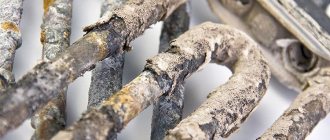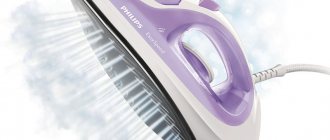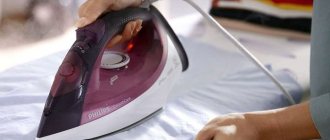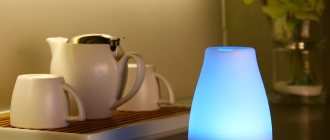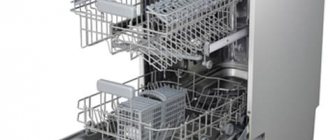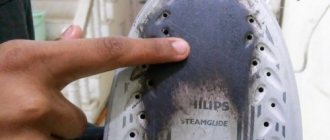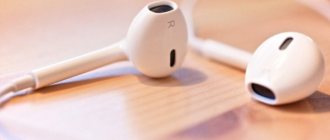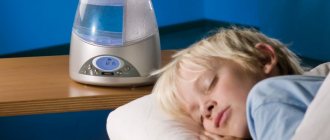A piece of climate control equipment known as a humidifier is present in almost every home. It is indispensable during the heating season by maintaining an optimal level of humidity in the room. The electrical appliance requires proper operation and proper care. These features depend on its variety. For example, the ultrasonic option requires timely removal of limescale. You can descale your humidifier using available means.
Why does plaque form?
The device is used to increase the moisture content in the air, which may decrease due to:
- operation of heating devices;
- incorrect design of the location of doors and windows in the house;
- the presence of the so-called sunny side in the room;
- high or low temperatures in winter and summer.
Important! The optimal level of humidity is 40-75%.
The device allows you to maintain good health. Low hydration may cause weakness, general discomfort and dizziness. An electrical appliance is also needed to clean the room from microscopic dirt and dust. A humidifier is necessary for people with chronic respiratory diseases.
The mechanism of operation of the device depends on its type:
- cold or hot humidifiers (use cold or hot steam, respectively);
- ultrasonic devices.
An air humidifier requires systematic maintenance, in particular cleaning. The device operates using water that is poured into the tank. It often causes the appearance of mineral deposits on the walls. This is why the use of tap water is considered undesirable.
The formation of scale is a natural process. Hard water contains calcium, magnesium and other biological substances. When water evaporates, scale forms on the parts of the device and its internal walls. Plaque shortens the life of the device and negatively affects air quality.
Important! Operating the device without regular cleaning releases harmful substances. To simplify the procedure for caring for the device, you should fill it with boiled or filtered water if possible. We recommend reading: How to remove brilliant green from linoleum
Types of Humidifiers
Manufacturers offer several types of devices to improve the microclimate. The following options can be purchased:
- cold humidification device (produces cold steam);
- hot humidification device (with hot steam);
- ultrasonic humidifiers (an ultrasonic element turns water into dust).
In order for the device to function fully, it needs periodic cleaning.
Which humidifiers can use water with additives?
Not all humidifiers allow the use of additives. For example, only clean water can be added to ultrasonic machines. In steam humidifiers, you can use decoctions and infusions of herbs or add essential oils. Traditional humidifiers can be filled with water and aromatic oils, and some models have a separate place for a piece of cotton wool soaked in aromatic substances. Before using additives, you should carefully study the instructions for the device, which should indicate how to fill it correctly.
Cleaning procedure
Scale is a dense mineral deposit that forms on the side surfaces of the tank. To clean a household humidifier from deposits, you need to do the following:
- Turn off the device. Remove the tank from the base and disassemble it into elements.
- Free it from water and rinse.
- Treat the inner surface with a cleaning compound. Use a soft sponge to remove softened scale.
- Wipe the outer part of the body with a flannel soaked in diluted table vinegar (3%).
In ultrasonic humidifiers, you need to clean the membrane surface with a special brush. It is included in the package.
How often should I clean?
Cleaning your humidifier is an essential part of a comprehensive procedure for maintaining its performance. In this case, the reason for contamination of the device lies in the principle of its operation and depends on the version of the selected model.
For example, the operation of steam humidifiers is often compared to the operation of an electric kettle - during the boiling process, water turns into steam and, combining with air, significantly increases its humidity. However, when boiling, all salts and other mineral compounds do not evaporate, but are deposited on the heater, forming a hard limescale deposit.
It is important to understand that plaque is not only an aesthetic nuisance, because it negatively affects the performance of the device, significantly reducing its heating function and contributing to early breakdown.
The operating principle of ultrasonic devices looks somewhat different. A special membrane, through the ultrasonic vibrations it creates, breaks moisture into fine particles, which are subsequently mixed with the surrounding air. In this case, the salts contained in the water settle both on the internal parts of the unit and on the surfaces surrounding it (furniture and walls).
The traditional version of the humidifier works by creating an air flow based on contact with a wet cartridge, forming a process of evaporation of moisture. In this case, all mineral salts remain in the cartridge, clogging it and thereby disabling the device.
If used regularly, the humidifier must be cleaned at least once a week, thoroughly wiping and removing salt deposits.
Why is scale dangerous?
Many humidifier users often don't even pay attention to the inside of the humidifier until it breaks. However, descaling of any type of humidifier should be done regularly to prevent a number of possible problems:
- The appearance and spread of pathogenic microorganisms.
- Flowering water.
- The appearance of mold.
- Formation of various types of chemical compounds that negatively affect human health.
- Deterioration of the device.
- Reducing the service life of the humidifier.
We recommend that you read: No steam coming out of the humidifier
Thus, it is necessary to remove scale and deposits from humidifiers with some regularity. However, at the same time, we should not forget about the use of proactive measures that would not allow such problems to arise. Thus, in particular, it is necessary to use preventive and disinfection measures. If scale has already appeared, then you should know how to clean the humidifier without harming it.
Methods for cleaning scale in a humidifier
In order to understand how to descale an air humidifier, you should figure out which model of air humidifier is in the house, and then study the operating instructions.
Depending on the method of humidification, devices are:
- Ultrasonic.
- Traditional or mechanical - with cold evaporation.
- Ionic (electrostatic).
- Steam.
Ultrasonic
Inside the ultrasonic device there is a membrane that is driven by sound waves. The liquid falling on it is converted into small steam particles, which are dispersed throughout the room by the built-in fan.
To remove scale from this appliance you must:
- empty the reservoir of any remaining liquid;
- rinse it thoroughly under running water;
- carefully clean all parts of the device from plaque, use a soft sponge or brush for this; it is not advisable to use an abrasive agent, as it can damage the surfaces;
- the remaining scale is removed using a vinegar solution (1 tablespoon per 0.5 liter of water), which is filled into the container and left for several hours; vinegar can be replaced with citric acid;
- then wash well and wipe dry with a towel.
Mechanical
The operating principle of mechanical humidifiers is the natural evaporation of liquid without heating. Contamination of such a device can be cleaned without the use of special products. Regular care and fluid replacement will improve its performance.
Ionic
Ionic models perform the following functions:
- increase indoor humidity;
- clean the space from dust, wool, unpleasant odors;
- improve and aromatize the air.
In addition to cleaning the water tank, they require filter replacement.
Steam
Steam humidifiers are most susceptible to scale formation. The evaporation of steam in these models occurs due to the boiling of water. You can remove plaque in the same way as cleaning an electric kettle.
Causes of pollution
The household appliances market is replete with humidifiers of various configurations. The type of device affects air exchange and its physical characteristics. The causes of contamination vary depending on the type of installation:
- Mechanical. A salt coating forms on a wet cartridge due to the increased level of salts and chlorine in the water. Mechanical units are susceptible to stagnation of water in the tank - this provokes the development of a pathogenic environment and the proliferation of bacteria. The process of decomposition of the liquid is accompanied by a putrid odor and the walls of the tank turning green.
- Steam. Air is generated with steam, causing salt molecules to separate from the air molecules. Due to their settling, scale forms on the inside of the tank. The lime layer compacts, reducing the thermal conductivity properties of the unit. Its performance deteriorates and breakdowns occur. To avoid problems, it is recommended to purchase units with moisture evaporation at room temperature.
- Ultrasonic. Ultrasound provokes the release of wet dust on the surface of the water. Salt molecules are separated from the components of air and liquid and settle on the inner surface. A white coating covers the walls and parts of the device.
- Combined. They have an air filtration function, in which the air flow passes through a humidified cartridge. The cleaning process consists of washing the filter and water tank. How to quickly remove shoe paint from shoes, the best cleaning methods
The above types of devices are characterized by blooming, coloring of the liquid green, and the appearance of an unpleasant odor from the tank. Humidifier treatment consists of regular cleaning and disinfection.
How to descale a humidifier
To remove scale from the humidifier, you need to remove the water container and also disconnect other removable parts. Before adding the cleaning agent, you must pour out the remaining liquid from the tank. The tank is thoroughly washed under the tap, and the body is wiped using a soft cloth. It is moistened in a concentrated solution of vinegar essence. This procedure prevents dust from settling on the surface.
How to descale a humidifier with citric acid
To remove mineral deposits, it is not necessary to purchase household chemicals. You can descale your humidifier using citric acid. The natural substance eliminates dirt and unpleasant odors.
Cleaning a humidifier from scale with citric acid is a simple procedure. The reservoir is filled with water and 60 g of powder is added. The device must be turned on for 1 hour. Then the dirt must be cleaned with a sponge.
Citric acid softens plaque, which causes it to peel off from the walls of the device
Vinegar
The essence allows you to remove scale from the humidifier by softening it. The composition includes concentrated vinegar (100 ml) and boiled (filtered) water corresponding to the maximum volume of the tank. The prepared solution is poured into the cleaning tank and the device is turned on. The operating time of the device is 30 minutes.
Vinegar essence helps clean scale and other contaminants
Soda
Sodium bicarbonate fumes are not dangerous, which makes it possible to clean indoor air conditioning equipment. Pour water into the reservoir, add baking soda (60 g) and stir thoroughly. The device should be turned on for 1 hour. Then the tank is thoroughly washed.
We recommend reading: Baking soda: beneficial properties, uses, how to take
Baking soda removes mineral deposits and disinfects appliance surfaces
By special means
The water tank should be washed using a soft cloth. Brushes with hard bristles should not be used. These products can compromise the integrity of internal parts and lead to intense accumulation of dirt. You can clean the device with a solution of laundry soap. After the procedure, wipe the device dry.
You can remove fresh scale from your humidifier without using special cleaning compounds. For this purpose, it is recommended to use a toothbrush that has soft bristles.
Attention! It is prohibited to rub the surface of the device intensively during cleaning. Otherwise, scratches may occur.
You can get rid of hard scale in your humidifier using special cleaning products. The composition is applied to the surface following the manufacturer's recommendations.
Antiscale effectively removes limescale deposits in electrical appliances
Universal care instructions
The humidifier constantly needs preventative cleaning, even if it is new and has not yet become “overgrown” with a thick layer of plaque. This usually involves washing all parts with either clean water or a special solution. But no matter what kind of humidifier you have, the same instructions for regular maintenance can be applied to it.
Step-by-step instructions:
If the manufacturer has not left precise instructions for cleaning the filter, then rinse it with clean water to avoid damage.
If you decide to more seriously clean the filter of your home humidifier, proceed in the following order:
- Turn off the device.
- Carefully disconnect and remove the filter.
- Rinse under running water.
- If any dirt remains, soak in a solution of citric acid.
- Gently go over all critical areas with a soft brush.
- Wash away any remaining plaque with water.
- Dry and place on the workbench.
It is better to study the characteristics of the filter in advance by looking at the instructions. Some models have replaceable cartridges - they need to be changed on time. But there are also replaceable parts that you can clean several times yourself, and then buy new ones.
How to deal with white residue from a humidifier
If a white coating appears on furniture surfaces, this does not mean that you need to buy another humidifier. Precipitation does not mean a breakdown, but indicates improper use of the device. Therefore, it is necessary to find the reason for the appearance and analyze your actions. In most cases, the problem lies in stagnant or hard water, so it will need to be replaced. If plaque continues to form on surfaces, it is worth using other methods.
Changing water
Adding running water to the fluid compartment is a common mistake. High-quality water does not always flow from the tap; most often it is hard or has sediments that can be clearly seen at the bottom of the glass. Therefore, first of all, it is necessary to boil water, and only then pour it into the tank. If this does not help, it is better to use distilled liquid, which is sold in all household stores.
Filter installation
Special built-in filters can eliminate plaque formation or delay its appearance. The following types of built-in filters stand out on the modern market: carbon, fiberglass or ion exchange resin. The principle of operation is the same, the only difference is the cost. A carbon filter is inexpensive, but the cost of others can reach 5 thousand rubles.
Buying an ultrasonic humidifier
An ultrasonic humidifier is a device that filters evaporating liquid. The difference from a conventional humidifier is the presence of a filter that filters out sediment and bacteria. You can add running water to such a device without pre-treating it. A humidifier will do this. Such a system is much more convenient, which is reflected in the cost of ultrasonic humidifiers. But even in such cases, you should not relax and forget about the correct operation of the device. Filters need to be changed every 3 months, otherwise the appearance of white deposits cannot be avoided again.
Reverse osmosis installation
This option is the most expensive, but also the most effective. This method will not only prevent the appearance of plaque, but will filter the entire flow of water entering a particular room. A reverse osmosis system is installed in the water supply, as a result of which the liquid is purified from salts and impurities and supplied to users in its pure form.
How to disinfect a humidifier?
Disinfecting the humidifier helps destroy pathogenic bacteria. The procedure must be carried out once every 14 days. For disinfection, you do not need to purchase additional compounds; the simple and accessible components available in the house will be sufficient.
White
For 1.1 liters of cool water, take 6 ml of chlorine bleach. Fill the reservoir with the solution and wait 60 minutes. There is enough time for complete disinfection. If you leave the solution longer, it can cause cracking of the tank walls.
Advice! To remove the bleach aroma, fill the humidifier reservoir with clean water and activate it. When steam formation begins, turn off the power to the device and pour out the water. Repeat steps until the bleach smell is completely eliminated.
Hydrogen peroxide
Pour 500 ml of the drug into the reservoir, wait 60 minutes. Then drain the peroxide and rinse the tank with clean water. There is no need to worry that particles of peroxide will remain on its internal surfaces. During evaporation, the remaining composition will disintegrate into oxygen molecules and water.
Table vinegar
Vinegar not only dissolves scale, removes fungi and mucus, but also helps disinfect the device. Dissolve 260 ml of product in 4.5 liters of water. Fill the tank and turn on the device for 1 hour. Cleaning should be done outdoors. After disinfection is completed, discard the liquid. Fill the humidifier tank with clean water. Let it run until steam forms. After this, drain the liquid again.
Disinfection of the device
There are 3 effective ways to disinfect your humidifier and complete a complete cleaning of the device:
1. Use a solution of bleach mixed with water.
- Pour a mixture of bleach and water into the tank in a ratio of 5 ml per 1 liter, respectively (carry out the procedure using only product compositions recommended by the manufacturer with an acceptable chlorine content).
- Soak for one hour until the inside of the tank is disinfected (if exposed for longer, this solution may damage the device).
- Pour out the solution and rinse the tank with clean, cold water.
- Fill the humidifier tank with a fresh portion of water and turn it on until steam formation occurs.
- Turn off the appliance before steam escapes into the room.
- Drain the used fluid and rinse the tank again.
- Repeat these steps until the characteristic bleach smell disappears completely.
2. Use hydrogen peroxide.
- Pour 1-2 cm of hydrogen peroxide into the bottom of the tank.
- Rotate it so that the liquid reaches both the bottom and sides inside the tank.
- Soak for one hour.
- Pour out the peroxide and rinse the humidifier container with cold water.
3. Clean the humidifier thoroughly with vinegar.
- Fill the tank with a solution at the rate of 250 ml of 9% vinegar and 4 liters of water.
- Connect the humidifier and let it run for one hour (do this outdoors or point the spout of the humidifier to be cleaned at an open window or vent).
- Drain the used liquid and wash the tank.
- Fill the container with clean water and repeat the procedure.
- Rinse the tank again before using the humidifier.
Features of cleaning an ultrasonic humidifier
The device is cleaned using the same methods, using soda, vinegar, and citric acid. Hydrogen peroxide is used for disinfection. The ultrasonic device is not turned on, the prepared liquid is poured into the tank and left for half a day, it gradually softens. Residues are removed with running water.
To clean an ultrasonic humidifier, turn it on, remove the reservoir and remove any remaining water, then rinse thoroughly. To treat the base, use vinegar or a solution based on a substance; it is applied with a sponge. To clean the membrane, use the brush included in the kit.
Disinfecting your humidifier also involves descaling. To remove plaque, you need to pour the prepared product into the tank and leave for 6 hours. During this time, the dirt will become wet; you will need to remove it with a soft cloth, then dry it and assemble the device. Do not use household chemicals (dishwashing liquid, floor liquid, plumbing solution, etc.).
What will help against mold, slime and greens?
Disinfection can rid the device of mold, greenery and mucus; there are three main ways to do it:
- Using bleach or bleach. Dilute a teaspoon of the reagent with 4.5 liters of water and pour it into the tank. The solution should be left in the container for an hour, after which the liquid should be drained and the container should be washed thoroughly under running water.
- Using vinegar. For the same volume of water, take a glass of vinegar and leave it in a working device for one hour (for ultrasonic humidifiers - in a non-working one). It is recommended to carry out the procedure outdoors, otherwise the room should be well ventilated.
- Peroxide. Pour several glasses of solution into the tank and leave for one hour. In this case, the peroxide should cover both the bottom and the walls.
Regular cleaning of the humidifier with baking soda and lemon can prevent the appearance of mold.
Cleaning filters
Filters are included with the humidifier. They are changed after several months. But it is necessary to remove plaque from them regularly. The filters are placed under running water and then dried.
The use of chemicals is contraindicated for two reasons. The first is that under the influence of chemistry, parts will quickly become unusable. The second is that the remaining chemical substance will be mixed with water and, when sprayed, will enter the air that households will breathe. Toxic ingredients will cause nausea, headaches, and malaise.
The membrane is cleaned using a special brush. It can also be found in packaging as an addition to a humidifying device. A sponge or piece of fleece can be a good substitute.
Only water can be used to clean the humidifier filters.
Rules of care and prevention of contamination
To keep the device in excellent condition, you must follow simple rules:
- Take proper care of the device and disinfect it once every 10-12 days. The procedure will prevent the proliferation of microorganisms that enter the air.
- The appliance should be descaled once every 7 days. This will extend its service life and prevent breakdowns. If you do not regularly descale the device, its performance will decrease and its service life will be shortened.
- It is better to carry out cleaning and disinfection in the fresh air, in which case harmful substances will evaporate faster.
- If folk remedies for cleaning and disinfection do not give good results, you should purchase strong chemicals.
- To prevent scale from appearing too often, you need to use filtered or boiled water. It is recommended to empty it after use. If the water stagnates, a favorable environment for mold fungi is created.
- To extend the service life of the device, you should change the operating mode. It is important to remember that the equipment must rest. It is forbidden to pour in too little or too much water; you must follow the manufacturer’s recommendations.
- If any parts wear out, they must be changed in time, otherwise the device will not be able to function.
- It is important to monitor the condition of the filter and membrane.
- It is not recommended to use a device with defects; it is better to replace it with a new one.
Before cleaning the humidifier, you need to disassemble it. Then choose the most convenient method and purchase the necessary funds.
What solutions should not be used?
Wanting to achieve perfect cleanliness, users rub their devices with various compounds that are harmful not only to the plastic, but also to the health of the owners of the equipment themselves. To prevent them from accidentally being poisoned by harmful fumes, especially responsible manufacturers include in the instructions a long list of substances that are strictly prohibited to use. The list of permitted means, by the way, is much shorter.
The following are usually listed as prohibited:
- chlorine and any chlorine-containing solutions;
- aggressive concentrated acids;
- alcohol and alcohol-containing solutions;
- hydrogen peroxide;
- compositions with essential oils;
- petrol;
- kerosene;
- acetone and other solvents;
- toilet cleaners, etc.
Even light acidic products approved for use should not be left for long, as they can damage the structure of the material and significantly reduce the service life of the device.
Rules for choosing a humidifier
The humidifier is selected according to the availability of functions, power, operating principle
Dry air and high temperatures in the apartment have a negative impact on the health of adults and children. This is especially critical in the autumn-winter period, when atmospheric indicators are significantly higher than normal. A high-quality air humidifier will help solve this problem; when choosing it, the following points are taken into account:
- type of device purchased (mechanical or ultrasonic);
- performance;
- the presence of additional options (the ability to control humidity using a built-in sensor, for example, or remote control);
- reputation of the model manufacturer.
Taking these factors into account will help you choose the best humidifier, which, according to most users, includes some ultrasonic class models. This unofficial rating highlights products from the following companies:
- SENDO M200;
- KOENIG AIR 380;
- XIAOMI CJJSQ01ZM;
- PANASONIC F-VXR50R.
Relatively inexpensive, high-quality humidifiers include devices produced by the manufacturers Galaxy (model GL-8003) and Polaris (PUH 6504).
